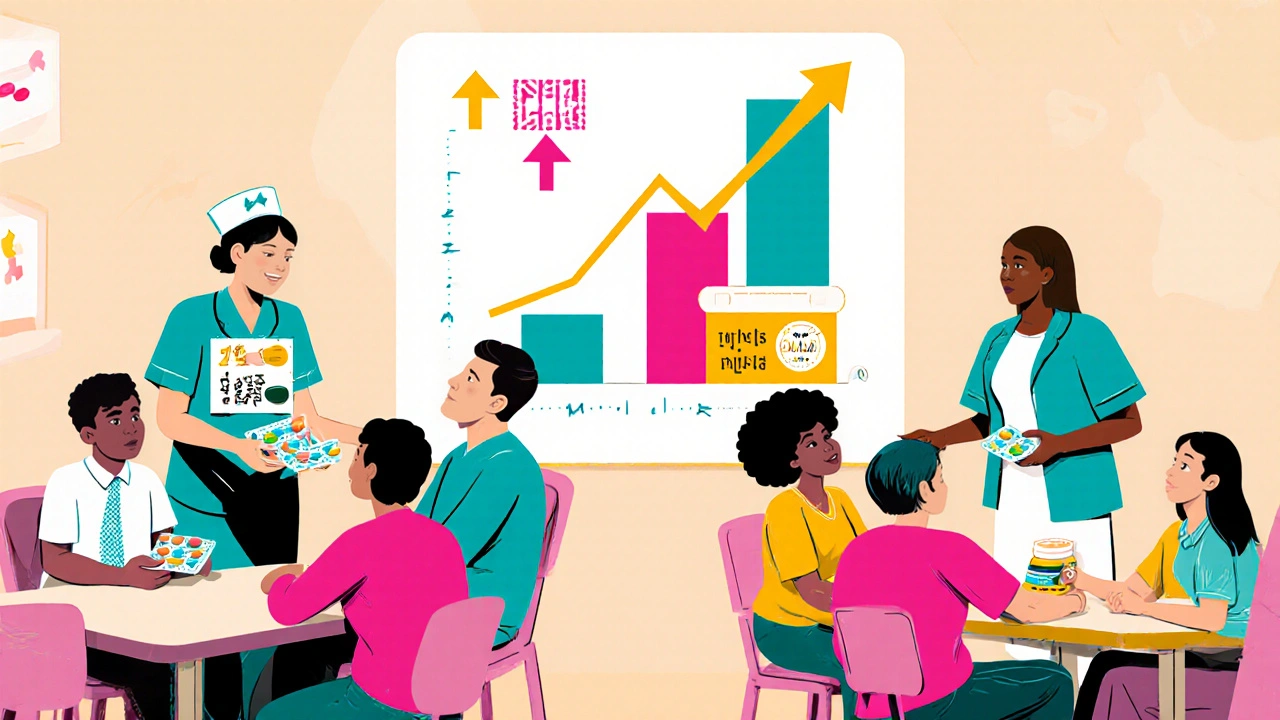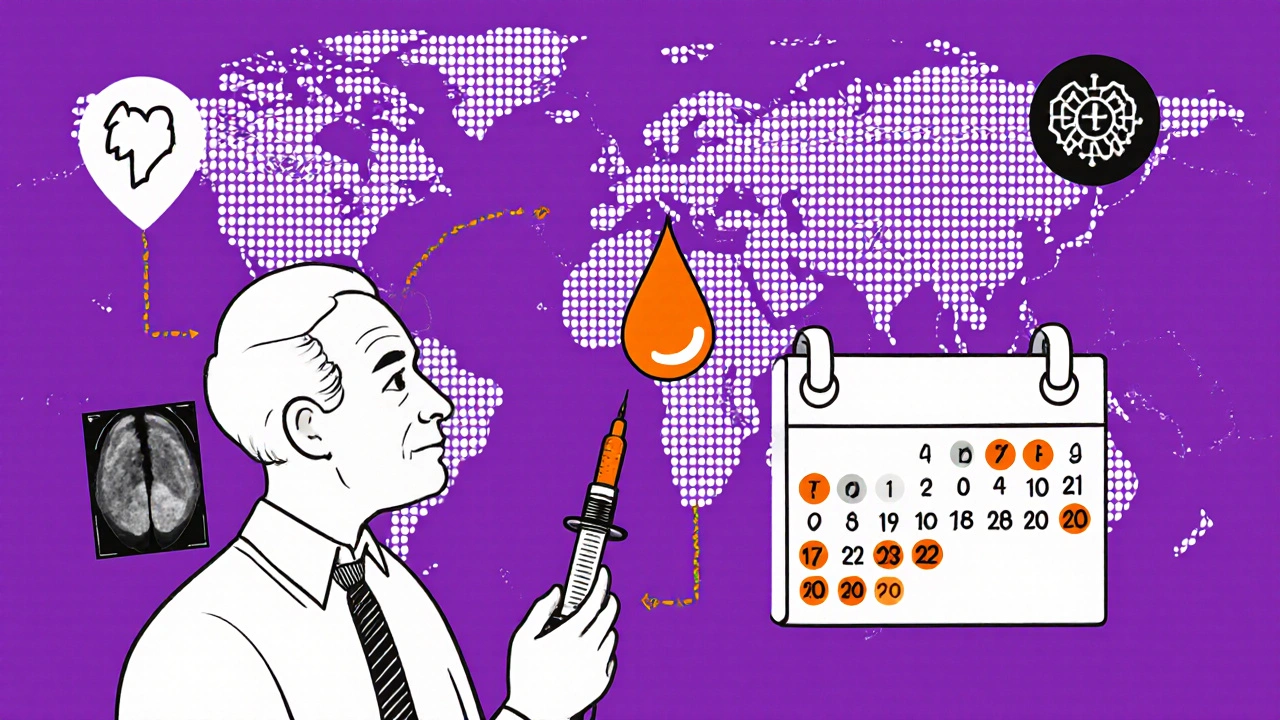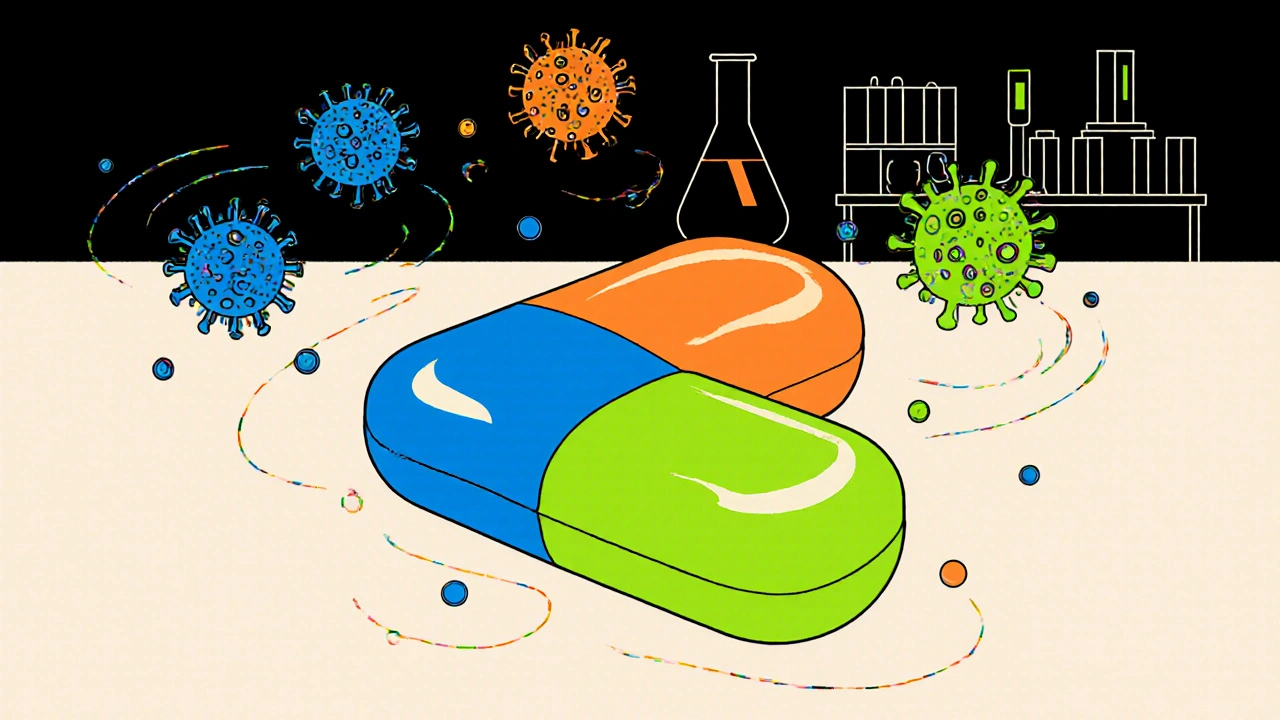Viral Load Reduction Calculator
How This Tool Works
This calculator uses data from clinical trials like ACTG 5095 to show how viral load typically decreases with the Efavirenz-Emtricitabine-Tenofovir regimen. Enter your starting viral load and time since treatment to see expected results.
Note: Actual results may vary. "Undetectable" typically means less than 50 copies/mL. This is not medical advice.
Expected Result
Enter your values to see estimated viral load reduction.
Your viral load is expected to be undetectable (<50 copies/mL) by this time. This is a strong indicator of treatment success.
Efavirenz‑Emtricitabine‑Tenofovir (commonly known as Atripla) is a fixed‑dose combination pill that packs three antiretroviral agents into one tablet. It was the first once‑daily regimen to simplify HIV therapy and quickly became a cornerstone of first‑line treatment worldwide. This article walks through the pivotal clinical trials that proved its efficacy, uncovered safety signals, and keep the regimen relevant two decades after launch.
What the regimen contains and why it matters
The three drugs target HIV at different stages:
- Efavirenz - a non‑nucleoside reverse transcriptase inhibitor (NNRTI) that blocks the reverse‑transcriptase enzyme.
- Emtricitabine - a nucleoside reverse transcriptase inhibitor (NRTI) that mimics cytidine.
- Tenofovir disoproxil fumarate (TDF) - another NRTI that resembles adenosine.
This triple attack crushes viral replication, raises CD4 counts, and reduces the risk of resistance when taken consistently. The convenience of a single pill taken once daily helped improve adherence, a key driver of long‑term success.
Key clinical trials that shaped the regimen
The story begins with a series of rigorously designed Phase III studies, most notably the ACTG 5095 trial. Conducted by the AIDS Clinical Trials Group (ACTG), ACTG 5095 enrolled over 1,600 treatment‑naïve adults across North America and Europe. Participants were randomized to receive either efavirenz + emtricitabine + tenofovir (the triple combo) or a control regimen of efavirenz plus two other NRTIs (lamivudine + zidovudine).
Primary endpoints were:
- Proportion of patients achieving plasma viral load < 50 copies/mL at week 48.
- Mean increase in CD4 count from baseline.
The results were striking: 71 % of the triple‑combo arm reached undetectable viral load versus 61 % in the control arm, and the CD4 rise averaged 213 cells/µL compared with 187 cells/µL. The trial also demonstrated non‑inferior safety, paving the way for regulatory approval in 2006.
Efficacy outcomes from Phase III studies
Beyond ACTG 5095, several multinational studies reinforced the regimen’s potency. The INSERT trial (2007) compared the triple combo against a boosted protease inhibitor regimen in over 1,200 patients from sub‑Saharan Africa and Asia. At week 96, viral suppression rates remained above 80 % in both arms, but the once‑daily pill showed superior adherence scores (average 94 % vs 87 %).
A pooled analysis of 12 Phase III trials (total n ≈ 7,800) reported a 5‑year durability of viral suppression of 78 % with low rates of confirmed virologic failure (< 6 %). These numbers helped the World Health Organization (WHO) endorse the regimen as a first‑line option in its 2017 consolidated guidelines.

Safety profile uncovered by trials
Adverse events (AEs) were closely tracked. Common AEs included mild rash (≈ 12 %) and central‑nervous‑system symptoms such as dizziness and vivid dreams (≈ 15 %). Serious AEs were rare (< 1 %). Renal function monitoring was emphasized because tenofovir can affect glomerular filtration; however, only 1.3 % of participants experienced a ≥ 25 % decline in eGFR at week 48.
Long‑term safety data from the 10‑year extension of ACTG 5095 (ongoing as of 2025) show stable renal parameters in the majority of patients, with grade 3-4 nephrotoxicity occurring in less than 0.5 %. These findings reassured clinicians that the regimen could be used broadly, including in resource‑limited settings where laboratory monitoring is less frequent.
Resistance monitoring and trial data
Resistance testing was integral to every pivotal study. In ACTG 5095, only 2 % of participants who experienced virologic failure developed NNRTI‑associated mutations (K103N, Y181C). The high genetic barrier of tenofovir and emtricitabine helped suppress NRTI‑resistance pathways.
Subsequent studies, such as the SPARTAN trial in 2014, investigated the impact of pre‑existing NNRTI resistance on treatment outcomes. Patients with baseline K103N still achieved 68 % suppression at week 48 when switched to the triple combo, highlighting the regimen’s forgiving nature when paired with good adherence.
How new trials keep the regimen relevant
Even after FDA approval, the regimen continues to be evaluated in modern contexts:
- PrEP crossover studies - trials like HPTN 082 examined whether switching from daily oral PrEP (tenofovir/emtricitabine) to a full triple combo could reduce HIV acquisition in high‑risk serodiscordant couples.
- Long‑acting formulations - recent Phase IIb trials are testing injectable versions of efavirenz combined with long‑acting tenofovir alafenamide (TAF), seeking to maintain the same efficacy with quarterly dosing.
- Simplification for aging cohorts - the GLOW study (2023) focused on patients over 60, measuring bone mineral density changes and cardiovascular risk. Findings suggest the triple combo remains a viable option when paired with regular screening.
These ongoing investigations ensure clinicians have up‑to‑date evidence when deciding whether the classic regimen fits a particular patient’s lifestyle or comorbidities.

Practical guidance for clinicians
When prescribing the triple combo, consider the following steps:
- Confirm baseline viral load and CD4 count. Ideal candidates have < 100,000 copies/mL and CD4 > 200 cells/µL, though the regimen works across a broad range.
- Screen for contraindications: active psychiatric illness, uncontrolled seizures, or use of strong CYP450 inducers (e.g., rifampin).
- Order baseline renal function (eGFR) and hepatic panel. Repeat eGFR at weeks 12 and 48 if initial value is < 60 mL/min/1.73 m².
- Educate patients about potential CNS side effects during the first few weeks; advise taking the pill at bedtime if vivid dreams occur.
- Schedule viral load testing at weeks 4, 12, and 24; aim for < 50 copies/mL by week 24.
- If virologic failure occurs, obtain resistance testing before switching regimens.
Adherence counseling is essential. The once‑daily nature reduces pill fatigue, but missed doses can quickly lead to rebound viremia given the short half‑life of efavirenz.
Quick checklist
- ✓ Confirm no contraindicated drug interactions.
- ✓ Baseline labs: viral load, CD4, eGFR, liver enzymes.
- ✓ Counsel on CNS effects and timing of dose.
- ✓ Arrange viral load checks at weeks 4, 12, 24.
- ✓ Plan resistance testing if VL > 200 copies/mL after 24 weeks.
Comparison with other first‑line regimens (2025)
| Regimen | Once‑daily pills | 48‑week suppression (≈ %) | Common AEs | Renal impact |
|---|---|---|---|---|
| Efavirenz‑Emtricitabine‑Tenofovir (Atripla) | Yes (single tablet) | 71 | Rash, CNS symptoms | Minimal; monitor eGFR |
| Dolutegravir/Abacavir/Lamivudine (Triumeq) | Yes (single tablet) | 85 | Insomnia, headache | None (no TDF) |
| Bictegravir/Emtricitabine/TAF (Biktarvy) | Yes (single tablet) | 89 | Weight gain, nausea | Very low (TAF) |
All three regimens achieve high suppression, but efavirenz‑based therapy still holds value for patients who cannot access newer integrase inhibitors due to cost or formulary restrictions.
What makes efavirenz‑emtricitabine‑tenofovir a good first‑line choice?
Its single‑tablet, once‑daily format simplifies treatment, clinical trials have shown durable viral suppression, and the resistance barrier is high when patients stay adherent.
Are there any groups that should avoid this regimen?
Patients with uncontrolled psychiatric illness, active seizures, or those taking strong CYP450 inducers (e.g., rifampin) are generally steered toward alternative regimens.
How often should kidney function be checked?
Baseline eGFR is required. If the value is ≥ 60 mL/min/1.73 m², repeat testing at 12 weeks and then yearly; lower baselines call for more frequent monitoring.
What does the latest research say about long‑acting versions?
Phase IIb trials of injectable efavirenz combined with long‑acting tenofovir alafenamide have shown comparable suppression rates to oral tablets, with dosing intervals of every 12-16 weeks under investigation.
Where can clinicians find updated trial results?
The AIDS Clinical Trials Group website, ClinicalTrials.gov, and the WHO consolidated guidelines release annual updates that summarize new evidence.


Comments
Nelson De Pena
When I first started prescribing Atripla back in 2008, the simplicity of a single daily pill was a game‑changer for my clinic.
Patients reported higher confidence in sticking to their regimen, and the viral suppression rates from ACTG 5095 matched what we were seeing in practice.
Keep sharing the success stories – they inspire colleagues and empower newcomers to HIV care.
Remember to pair the medication with clear counseling about CNS side effects, and the adherence numbers will keep climbing.
Let’s keep the momentum going and make every dose count.
October 23, 2025 AT 23:03
Wilson Roberto
Reflecting on the evolution of first‑line therapy, the balance between efficacy and tolerability emerges as a central philosophical question.
The data from the INSERT trial illustrate that a regimen can be both potent and patient‑friendly, shaping how we define “optimal” care.
It’s encouraging to see that real‑world adherence mirrors the trial’s high scores, reinforcing the value of simplicity.
By embracing both the science and the lived experience, we can craft treatment pathways that respect the individual’s daily life.
Stay curious, stay compassionate.
October 30, 2025 AT 23:03
Samantha Vondrum
It is incumbent upon clinicians to adopt an inclusive approach when selecting antiretroviral regimens, ensuring that each patient’s unique circumstances are considered.
The table comparing Atripla, Triumeq, and Biktarvy demonstrates that efficacy alone does not dictate the optimal choice; cost, renal function, and potential neuropsychiatric effects are equally pivotal.
Moreover, the ongoing long‑acting trials underscore the field’s commitment to expanding therapeutic options for diverse populations 😊.
Clinicians should therefore integrate guideline updates with a patient‑centered dialogue, fostering shared decision‑making.
Such a strategy not only aligns with best practice but also promotes health equity across varied demographic groups.
November 6, 2025 AT 23:03
Kelvin Egbuzie
Sure, the pharma giants love to tout Atripla as the “once‑daily miracle” – as if they haven’t been pumping us with profit motives for decades :)
What most people overlook is that the very same trials were funded by the manufacturers, a detail conveniently buried in the footnotes.
Even the safety data on CNS side effects were downplayed, leaving clinicians to discover the vivid dreams later on.
Don’t believe everything the label says; dig deeper, question the agenda.
November 13, 2025 AT 23:03
Taylor Nation
Collaborating across specialties has shown me that Atripla remains a solid backbone for many treatment‑naïve patients, especially when budget constraints limit newer integrase inhibitors.
When we pair the regimen with robust adherence counseling, the viral suppression rates consistently hit the high‑70s, matching the ACTG 5095 outcomes.
Assertively monitoring renal function at baseline and at 12‑week intervals safeguards against the rare nephrotoxicity cases.
Let’s keep the conversation open – sharing real‑world data helps refine our collective practice.
November 20, 2025 AT 23:03
Nathan S. Han
From the bustling corridors of the early 2000s to today’s cutting‑edge research labs, the saga of efavirenz‑emtricitabine‑tenofovir reads like an epic tale of scientific triumph.
The ACTG 5095 trial lit the first candle, enrolling over 1,600 naïve patients and demonstrating a striking 71 % rate of undetectable viral load at week 48 – a figure that reverberated through every HIV conference thereafter.
Not only did the study illuminate the potency of a triple attack, it also proved that a single tablet could shatter the barriers of pill fatigue that once plagued our field.
Subsequent investigations, such as the INSERT trial, cemented this narrative by showing adherence scores soaring above 90 % in sub‑Saharan cohorts, a testament to cultural adaptability and patient empowerment.
The longevity of Atripla’s relevance is underscored by the 10‑year extension data, where renal parameters remained remarkably stable for the vast majority, quelling early fears of tenofovir‑induced nephrotoxicity.
Even the occasional CNS side effects – vivid dreams, dizziness – have been managed effectively with simple counseling strategies, turning a potential drawback into an opportunity for clinician‑patient dialogue.
Meanwhile, resistance monitoring across multiple phases revealed a mere 2 % incidence of NNRTI‑associated mutations among virologic failures, highlighting the regimen’s high genetic barrier when adherence is maintained.
In the era of integrase inhibitors, cost considerations still keep Atripla on the front lines of care in many resource‑limited settings, where generic formulations offer a lifeline to patients otherwise denied access.
The ongoing HPTN 082 PrEP crossover studies further expand the drug’s horizon, exploring whether full triple therapy can act as an added shield for serodiscordant couples.
Innovations continue with long‑acting injectable formulations that marry efavirenz with tenofovir alafenamide, promising quarterly dosing while preserving the viral suppression rates documented decades ago.
Clinicians have responded with enthusiasm, integrating these findings into pragmatic guidelines that balance efficacy, safety, and socioeconomic realities.
Patient stories echo this sentiment: “I never missed a dose because it was just one pill,” says a longtime survivor, embodying the regimen’s core promise of simplicity.
From a public health perspective, the WHO’s endorsement of Atripla as a first‑line option in 2017 reflects a global consensus that the regimen’s benefits outweigh its modest drawbacks.
As we look ahead, the spirit of collaboration that birthed these trials reminds us that even an “old‑school” regimen can be revitalized through relentless research and compassionate care.
Let us therefore celebrate not merely the pill, but the collective dedication of investigators, providers, and patients who have made Atripla a cornerstone of HIV treatment for two decades.
November 27, 2025 AT 23:03
Ed Mahoney
Yo, if you’re still thinkin’ Atripla is the holy grail, maybe grab a coffee and read the newer integrase data – it’s kinda like using a flip‑phone in 2025.
Sure, the pill works, but the side‑effects can feel like a “free” bonus package you didn’t ask for.
December 4, 2025 AT 23:03